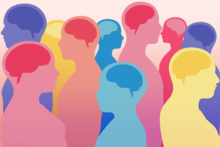
| Part of a series on |
| Discrimination |
|---|
 |
The neurodiversity paradigm is a framework for understanding human brain function that recognizes the diversity within sensory processing, motor abilities, social comfort, cognition, and focus as neurobiological differences. This diversity falls on a spectrum of neurocognitive differences.[1] The neurodiversity paradigm argues that diversity in human cognition is normal and that some conditions generally classified as disorders, such as autism, are differences and disabilities that are not necessarily pathological. Neurotypical individuals are those who fall within the average range of functioning and thinking.
The neurodiversity movement started in the late 1980s and early 1990s with the start of Autism Network International. Much of the correspondence that led to the formation of the movement happened over autism conferences, namely the autistic-led autreat, penpal lists, and Usenet. The framework grew out of the disability rights movement and builds on the social model of disability, arguing that disability partly arises from societal barriers, rather than attributing disability purely to inherent deficits.[2] It instead situates human cognitive variation in the context of biodiversity and the politics of minority groups.[3][4][5] Some neurodiversity advocates and researchers argue that the neurodiversity paradigm is the middle ground between a strong medical model and a strong social model.[6][7][8]
Neurodivergent individuals face unique challenges in education and the workplace. The efficacy of accessibility and support programs in career development and higher education depends on the individual.[9][10] Social media has introduced a platform where neurodiversity awareness and support has emerged, further promoting the neurodiversity movement.
The neurodiversity paradigm has been controversial among disability advocates, partly due to misunderstandings of neurodiversity paradigm, with opponents arguing it risks downplaying the suffering associated with some disabilities, and that it calls for the acceptance of things some would wish to be treated.[11][12][13][14][15]
- ^ Kapp SK, ed. (2020). Autistic Community and the Neurodiversity Movement. doi:10.1007/978-981-13-8437-0. ISBN 978-981-13-8436-3.
- ^ Botha M, Chapman R, Giwa Onaiwu M, Kapp SK, Stannard Ashley A, Walker N (March 12, 2024). "The neurodiversity concept was developed collectively: An overdue correction on the origins of neurodiversity theory". Autism. 28 (6): 1591–1594. doi:10.1177/13623613241237871. ISSN 1362-3613. PMID 38470140.
- ^ Manalili MA, Pearson A, Sulik J, Creechan L, Elsherif M, Murkumbi I, et al. (February 2023). "From Puzzle to Progress: How Engaging With Neurodiversity Can Improve Cognitive Science" (PDF). Cognitive Science. 47 (2): e13255. doi:10.1111/cogs.13255. PMC 7616419. PMID 36807910. S2CID 257068968. Archived (PDF) from the original on April 7, 2023. Retrieved April 6, 2023.
- ^ "Reflections on the Neurodiversity Paradigm: What is Neurodiversity?". Reflections on the Neurodiversity Paradigm. Archived from the original on April 1, 2023. Retrieved April 12, 2022.
- ^ Singer J (July 3, 2016). NeuroDiversity: The Birth of an Idea (2nd ed.). Kindle Ebook. ISBN 978-0-6481547-0-9.[self-published source?]
- ^ Dwyer P (May 2022). "The Neurodiversity Approach(es): What Are They and What Do They Mean for Researchers?". Human Development. 66 (2): 73–92. doi:10.1159/000523723. PMC 9261839. PMID 36158596. S2CID 247062174.
- ^ Oliver M, Sapey B (2006). Social work with disabled people (3rd ed.). Basingstoke, Hampshire: Palgrave Macmillan. ISBN 1-4039-1838-4. OCLC 62326930.
- ^ Chapman R (January 10, 2019). "Neurodiversity Theory and Its Discontents: Autism, Schizophrenia, and the Social Model of Disability". In Tekin S, Bluhm R (eds.). The Bloomsbury Companion to Philosophy of Psychiatry. Bloomsbury. pp. 371–387. ISBN 978-1-350-02406-9. Archived from the original on July 19, 2023. Retrieved May 12, 2020.
- ^ Cite error: The named reference
:110was invoked but never defined (see the help page). - ^ Cite error: The named reference
:32was invoked but never defined (see the help page). - ^ Opar A (May 6, 2019). "A medical condition or just a difference? The question roils autism community". The Washington Post. Archived from the original on December 9, 2019. Retrieved May 12, 2019.
- ^ Robison JE. "The Controversy Around Autism and Neurodiversity". Psychology Today. Archived from the original on March 22, 2023. Retrieved May 14, 2019.
- ^ McGee M (August 2012). "Neurodiversity". Contexts. 11 (3): 12–13. doi:10.1177/1536504212456175. S2CID 220720495.
- ^ Sarrett J (April 2016). "Biocertification and Neurodiversity the Role and Implications of Self-Diagnosis in Autistic Communities". www.researchgate.net. Archived from the original on March 6, 2022. Retrieved March 6, 2022.
- ^ Bailin A. "Clearing Up Some Misconceptions about Neurodiversity". Scientific American Blog Network. Archived from the original on June 29, 2019. Retrieved April 12, 2022.